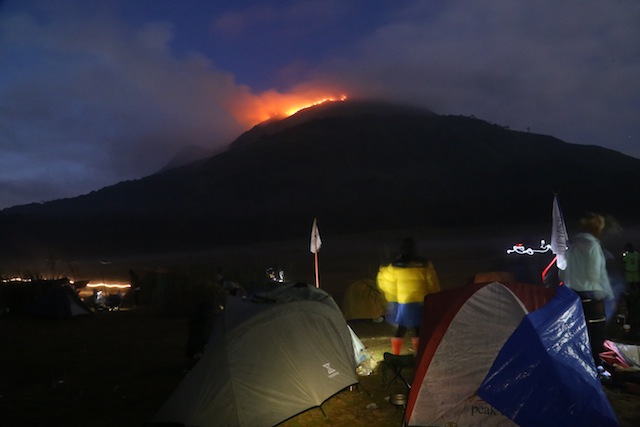DAVAO CITY (MindaNews/31 March) – The Holy Week climb to Mt. Apo this year was, like last year, “controlled” due to the drought, with only 1,000 climbers supposedly allowed to go up via the six trails in North Cotabato’s Kidapawan, Makilala and Magpet and Davao del Sur’s Digos, Sta. Cruz and Bansalan.
The number of climbers exceeded 1,000. According to the report of the Department of Tourism Region 12, the actual count of trekkers at the peak as of 10 a.m. of March 26 – or three hours before the fire started at the peak — was 989.
“This figure is just for March 26, 2016 at a particular time but the number was bigger on other times, and hence went beyond the 1,000 limit, as there are entry points that had exceeded their agreed allocation of trekkers,” the report said.
The fire was still raging Wednesday amid calls to close Mt. Apo to climbers for three to five years.
If rules had been strictly observed, however, Mt. Apo should have been closed to climbers this year.
 A group of mountaineers and bikers from Cotabato City watched the fire at the peak of Mt. Apo in this photo taken at 4:59 p.m. on Saturday (26 March 2016), as they set up tent in the camping site beside Lake Venado. The Cotabato group claimed three unidentified mountaineers who slept at the peak and cooked there may have caused the fire. Photo courtesy of TUTIN SAPTO / Cotabato All-Terrain Bikers Association (CATBA)
A group of mountaineers and bikers from Cotabato City watched the fire at the peak of Mt. Apo in this photo taken at 4:59 p.m. on Saturday (26 March 2016), as they set up tent in the camping site beside Lake Venado. The Cotabato group claimed three unidentified mountaineers who slept at the peak and cooked there may have caused the fire. Photo courtesy of TUTIN SAPTO / Cotabato All-Terrain Bikers Association (CATBA)
The Trekking Policy Resolution No. 2015-01 of the Mt. Apo Natural Park – Protected Area Management Board (MANP-PAMB) provides under policy number 19 six items on Fire Prevention measures: cooking shall only be done using portable burners (and) use of firewood is strictly prohibited; campfires are strictly prohibited in all trails and camp sites of Mt. Apo; no fireworks allowed; smoking is strictly prohibited; all trails shall be closed during the dry season and absence of rain for at least two months; and forest guards shall be deployed by the respective LGUs on the trails, to enforce closure during dry months.”
Despite these clear provisions of closure during dry months, despite the fact that North Cotabato and Davao del Sur have been placed under a state of calamity due to the drought, the climb was allowed but limited to 1,000 excluding porters, as agreed upon during the February 26 meeting of the MANP-PAMB in Digos City.
During that meeting, the impact of the drought on Mt. Apo was discussed and tourism officers of Makilala and Bansalan recommended closure to trekking. The four other tourism officers, however, suggested a limited climb, citing pre-booked climbers, according to the Mt. Apo Climb Summit Monitoring Update prepared for the Ecotourism Committee of the MANP-PAMB.
Fire on drought years
When the fire started at the peak Saturday noon, “mabuti na lang wala nang tao sa peak” (it was a good thing there were no more climbers at the peak,” Julius Paner, Senior Tourism Operations Officer of Sta. Cruz town told MindaNews in his office Monday morning.
Digos City’s Tourism Officer Edgardo “Bebot” Elera told MindaNews in Kapatagan, Digos City Monday noon that most of the climbers had gone down from the peak by then.
The last time Mt. Apo was on fire was in 1998, also a year of drought, Tourism Officer Joey Recemilla, chair of the Ecotourism Committee of the MANP-PAMB told MindaNews in a telephone interview.
Recemilla said the other fire incidents he witnessed were also on drought years – in 1977-1978, 1983 and 1998, the latter he described as “the worst” as it took months before the fire could be contained.
At that time, there was still no unified policy on climbing Mt. Apo and no coordination among local government units. He said this has been corrected and response mechanisms had been set up.
“Immediately we responded,” he added .
How Saturday’s fire started, no one can say with certainty. Elera said he “cannot say kung accident or deliberate.. Maybe somebody threw a cigarette butt.”
But he maintained that the local government units had not been remiss in reminding trekkers especially since there is already a unified trekking policy. Copies of the policy are given those who register to climb.
“Masyadong mataas ang possibility” (there’s a very high possibility) that trekkers caused the fire, Recemilla acknowledged.
Limited to 1,000
Recemilla said this year’s Holy Week trek to the country’s highest peak was supposed to be limited to only 1,000 climbers: 300 for those climbing via the Sta. Cruz trail in Davao del Sur, 200 for Digos City, also in Davao del Sur, 200 for Kidapawan City in North Cotabato and 100 each for Bansalan in Davao del Sur and North Cotabato’s Magpet and Makilala towns.
According to the Trekking Policy, Mt. Apo’s peak season for climbing is the Holy Week, from Monday to Sunday, and registration fee and exit fee for the climb is more expensive, at P1,500 each. The rest of the time, registration and exit fees cost P1,000 each. No exit fee is collected if the climber descends using the same trail for ascent.
Recemilla said Sta. Cruz exceeded the number of climbers beyond its allowable 300.
According to the DOT Region 12 report and the Mt. Apo Climb Summit Monitoring Update of the MANP-PAMB, as of 10 a.m. on March 26 or at least three hours before the fire started, the actual number of persons at the peak was 989 – trekkers, guides and porters, monitoring team members, vendors and illegal entrants.
Of this, a total of 537 reportedly came from the Sta. Cruz trail, 488 of them trekkers; 206 from Digos, 111 from Makilala, 96 from Bansalan, 23 from Kidapawan and 16 from Magpet.
As the DOT 12 report noted, this number only represents a certain time and that the number “was bigger on other times, and hence went beyond the 1,000 limit.”
“Still manageable”
Paner told MindaNews their count was 350 “including guides.”
Sta. Cruz was given the biggest quota because it had more pre-bookings. Paner explained that this is because the Sta. Cruz trail is the nearest from the airport and seaport of Davao City. There used to be a Davao City trail via Tamayong but this has been closed for years.
Paner said their excess number of 50 was “still manageable” and that it was difficult to turn away climbers because many came all the way from Luzon.
Elera said they registered at least 225 climbers, excluding the 140 Boy Scouts from high schools in Davao del Sur who took the Sta. Cruz trail but were briefed in Digos .
Asked if the 140 Boy Scouts were part of his list of 350 climbers, Paner said this was a separate list as the Boy Scouts were given a “special permit” by the mayor. But Paner said only 103 and not 140 Scouts climbed. “They used Kidapawan as an exit trail.”
According to Recemilla, protocol requires that when a fire is reported, climbers are to “immediately exit to the safest and nearest trail,” in this case, Kidapawan City.
The DOT 12 said that “according to reports, climbers denied entry in Makilala had proceeded to Sta. Cruz and were accommodated with the blessings of the Mayor.”
“Not true,” Paner told MindaNews on Thursday morning. “The mayor only instructed me to accommodate the Boy Scouts, wala nang iba. Nobody from Makilala came to us. In fact, kami pa nga ang nag-refer ng climbers sa ibang trails kasi nga puno na kami.”
Paner said that per their records, the total number of those who climbed via the Sta. Cruz trail was 453, including the 103 Boy Scouts and the 350 trekkers and guides.
Same as last year
Elera said Digos used to host around 700 trekkers during the Holy Week “but the Ecotourism Committee of PAMB saw the problem due to El Nino, that is why each trail was given a quota.”
He said he raised a question during the MANP-PAMB meeting on the Holy Week climb, “what shall I do with unbooked climbers who will walk in during Holy Week, let’s say coming from Manila and who are ready to climb? The committee replied, ‘okay let them climb.’ That’s why our Digos quota of 200 (exceeded) by 25 climbers.”
The Trekking Policy Resolution 2015-01 provides under Policy 5 that climbers must be pre-booked and a “no walk-in trekkers” policy “shall be strictly implemented.”
Last year, Recemilla said, Mt.Apo was closed to climbers due to the El Nino phenomenon. But the MANP-PAMB also opened it to 1,000 climbers citing the pre-bookings.
A report of the Manila Bulletin on March 20 last year said the closure decision was made following an emergency camp and trail assessment where they discovered problems in several trails and water sources especially near the peak.
“Many of the water sources have dried up. And the grasslands there, they have all dried up,” Recemilla said in the Manila Bulletin report. He noted that a cigarette butt could ignite a fire. (Carolyn O. Arguillas / MindaNews)
